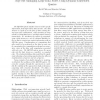Free Online Productivity Tools
i2Speak
i2Symbol
i2OCR
iTex2Img
iWeb2Print
iWeb2Shot
i2Type
iPdf2Split
iPdf2Merge
i2Bopomofo
i2Arabic
i2Style
i2Image
i2PDF
iLatex2Rtf
Sci2ools
HPDC
2000
IEEE
2000
IEEE
dQUOB: Managing Large Data Flows using Dynamic Embedded Queries
The dQUOB system satis es client need for speci c information from high-volume data streams. The data streams we speak of are the ow of data existing during large-scale visualizations, video streaming to large numbers of distributed users, and high volume business transactions. We introduces the notion of conceptualizing a data stream as a set of relational database tables so that a scientist can request information with an SQL-like query. Transformation or computation that often needs to be performed on the data en-route can be conceptualized as computation performed on consecutive views of the data, with computation associated with each view. The dQUOB system moves the query code into the data stream as a quoblet as compiled code. The relational database data model has the significant advantage of presenting opportunities for e cient reoptimizations of queries and sets of queries. Using examples from global atmospheric modeling, we illustrate the usefulness of the dQUOB system. We c...
Data Stream | Distributed And Parallel Computing | End-to-end Latency | HPDC 2000 | Relational Database |
| Added | 31 Jul 2010 |
| Updated | 31 Jul 2010 |
| Type | Conference |
| Year | 2000 |
| Where | HPDC |
| Authors | Beth Plale, Karsten Schwan |
Comments (0)

